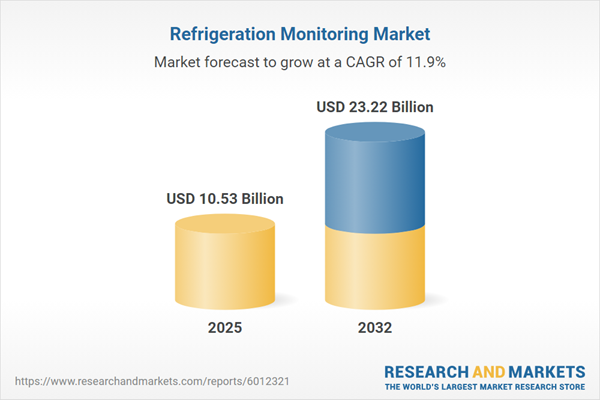Speak directly to the analyst to clarify any post sales queries you may have.
The refrigeration monitoring market is rapidly evolving, driven by regulatory compliance needs, risk management priorities, and advances in sensor and analytics technologies. Senior leaders across industries now view intelligent refrigeration oversight as strategic for operational resilience and cost optimization.
Market Snapshot: Refrigeration Monitoring Market Growth
The refrigeration monitoring market grew from USD 9.41 billion in 2024 to USD 10.53 billion in 2025 and is projected to reach USD 23.22 billion by 2032 at a CAGR of 11.94%. Demand is rising as food, pharmaceuticals, and logistics leaders invest in digital solutions to ensure the integrity of temperature-sensitive goods throughout global cold chains.
Scope & Segmentation of the Refrigeration Monitoring Market
- Component Types: Communication modules, controllers, power supplies, sensors including door, humidity, pressure, temperature, and software.
- Monitoring Types: Solutions cover CO2, door, humidity, pressure, and temperature monitoring for varied applications.
- Connectivity Types: Options include cellular, wired, and wireless (Bluetooth, LoRaWAN, Wi-Fi, Zigbee), supporting flexible installations and remote access.
- Application Areas: Cold storage (blast freezers, cold rooms, walk-in freezers), food processing (dairy, industrial, packaging), healthcare, pharmaceuticals, retail (convenience, department, hypermarkets, supermarkets), and transportation.
- Deployment Modes: Cloud (hybrid, private, public), on-premise (edge computing, local servers), catering to different control and security needs.
- Regional Coverage: Americas (North America, Latin America), Europe, Middle East & Africa (including UK, Germany, France, EMEA, GCC, Africa), and Asia-Pacific (China, India, Japan, Australia, Korea, Southeast Asia).
Key Takeaways for Decision-Makers
- Regulatory mandates for continuous data logging and real-time alerts are accelerating adoption of IoT-enabled refrigeration monitoring systems.
- Sensor advancements now deliver insights on not just temperature, but also on humidity, pressure, and equipment door status, providing comprehensive risk reduction.
- Interoperable connectivity and cloud-native software ecosystems are transforming monitoring from isolated devices to unified, actionable platforms suitable for both stationary and mobile cold storage needs.
- Regional variations drive localized innovation, with North America focused on retrofitting legacy systems and Asia-Pacific leading in edge computing adoption.
- Service-driven revenue models and modular solution design support tailored offerings for end users of all sizes.
Impact of United States Tariffs on Refrigeration Monitoring Supply Chains
Imminent tariffs in the United States are compelling organizations to recalibrate sourcing strategies for key refrigeration components. Increased duty rates on communication modules, controllers, and sensors produced overseas threaten to elevate procurement costs and disrupt supply chains. As a result, companies are prioritizing partners with local manufacturing capabilities, diversifying their supplier base, and considering nearshoring to maintain system availability and control expenses. Additionally, businesses are evaluating inventory strategies and working closely with logistics and customs professionals to anticipate and manage cost fluctuations caused by regulatory changes.
Methodology & Data Sources
Our insights draw from extensive interviews with manufacturers, system integrators, and end users, supplemented by a rigorous secondary review of industry publications, regulatory materials, and vendor documentation. Data was validated using triangulation and thorough peer review to ensure accurate identification of key refrigeration monitoring trends and challenges.
Why This Report Matters
- Enables leaders to benchmark competitive strategies, identify innovation opportunities, and optimize procurement amid regulatory and supply chain complexity.
- Offers segmentation and actionable recommendations for aligning technology investments with sustainability and operational priorities.
- Supports strategic planning with comprehensive, up-to-date coverage tailored to the needs of modern cold chain operations.
Conclusion
Refrigeration monitoring has become integral to risk mitigation, regulatory compliance, and operational efficiency. As industry requirements and technology capabilities grow more complex, aligning innovation, supply chain adaptability, and sustainability initiatives is critical for ongoing market leadership.
Additional Product Information:
- Purchase of this report includes 1 year online access with quarterly updates.
- This report can be updated on request. Please contact our Customer Experience team using the Ask a Question widget on our website.
Table of Contents
3. Executive Summary
4. Market Overview
7. Cumulative Impact of Artificial Intelligence 2025
List of Figures
Samples

LOADING...
Companies Mentioned
The key companies profiled in this Refrigeration Monitoring market report include:- Emerson Electric Co.
- Johnson Controls International plc
- Schneider Electric SE
- Honeywell International Inc.
- Carrier Global Corporation
- Siemens AG
- Danfoss A/S
- ABB Ltd
- Azbil Corporation
- Fuji Electric Co., Ltd.
Table Information
| Report Attribute | Details |
|---|---|
| No. of Pages | 185 |
| Published | October 2025 |
| Forecast Period | 2025 - 2032 |
| Estimated Market Value ( USD | $ 10.53 Billion |
| Forecasted Market Value ( USD | $ 23.22 Billion |
| Compound Annual Growth Rate | 11.9% |
| Regions Covered | Global |
| No. of Companies Mentioned | 11 |









